In my introduction post to this series, How to Live a More Old-Fashioned Life, I explained the heart of the matter. We need to find more balance in our lives. Doing so means pulling back from the internet a bit and learning to live a more old-fashioned life. So to continue on from there, in this post I am sharing specific ideas to implement more old-fashioned homemaking.
This more old-fashioned homemaking idea list is meant to inspire you. It isn’t meant to cover everything, but instead give some concrete examples of how you can add elements of old-fashioned homemaking into your life.
By pulling back from the way our culture is going, and reclaiming old-fashioned ways of life, we are gaining intentionality in our lives again. Instead of wasting our lives scrolling on our phones, we are learning what its like to live without.
I am fully aware of the fact that I am a blogger, and that this is a blog post you are reading. I don’t believe the internet or technology are inherently bad. As I’ve said before, I am firm believer that we cannot try to recreate the past. But instead, we can use the wisdom of the past in conjunction with today’s technology to create meaningful lives we are happy in. My intention is not for you to use every idea on this list but to choose the ideas that sound interesting to you and that work well for your family.
Many generations of old-fashioned homemaking ideas, instead of copying one specific time period
Also, I’m also not trying to copy a specific period of history. But instead, just use generally old-fashioned ways. If I were to pick an era of history like the 1950s versus the 1880s, old-fashioned homemaking would look different for each of those time periods. Of course, some of these ideas have stood the test of time from even before pioneer days; like cast iron cookware. But other ideas are things your grandmother may have done after the advent of plastics; like re-using finished yogurt containers for leftovers.
You can also fall down the proverbial “rabbit hole” pretty easily. For example, why stop at using cast iron cookware? Why not get an old-fashioned wood stove and cook your food on that? Or better yet, over a camp fire? You get the point. Yes, some of these ideas are harder to do and more in-depth. But what I was looking at for this list, were ways we could distance ourselves a bit from technology and do tasks more intentionally.
More Old-Fashioned Homemaking
Making food for your family
Cook from scratch & eat simpler, whole foods
With the amount of frozen dinners, take-out, and short-cut meals, making a meal from scratch can seem tedious. Sure, I don’t make meals from scratch every night. Sometimes, it’s using short-cut products to just get out a 30 minute meal. And that’s still great, because it’s making food for your family. But I do try and do meals from scratch as often as I can. Not only does it taste so much better, it’s healthier too. This is because you can control exactly what goes into the meal. It’s also cheaper; by buying raw, whole ingredients you’re saving tons of money. Another benefit to cooking from scratch is that you can extend the meal. Say you’re using a whole chicken, after it’s all eaten up, you can use the bones to make bone broth.
Cook with cast iron cookware
Cooking with cast iron is one of those things that may seem difficult but once you get the hang of it, it’s pretty simple. Over time, once my current pans wear out, I plan to fully convert to cast iron. Cast iron lasts, it’s heavy duty & cooks evenly. It’s even pretty to see hanging on a wall if that matters to you.
Reheat food on the stovetop or in the oven instead of the microwave
The microwave is certainly convenient, and I have and use one in my home. But I find that the food comes out so much tastier when I use the stovetop or oven. I know some people who don’t even own a microwave because they only do this instead. If you want to do more old-fashioned homemaking, you can try to use the microwave less often or forgo it altogether.
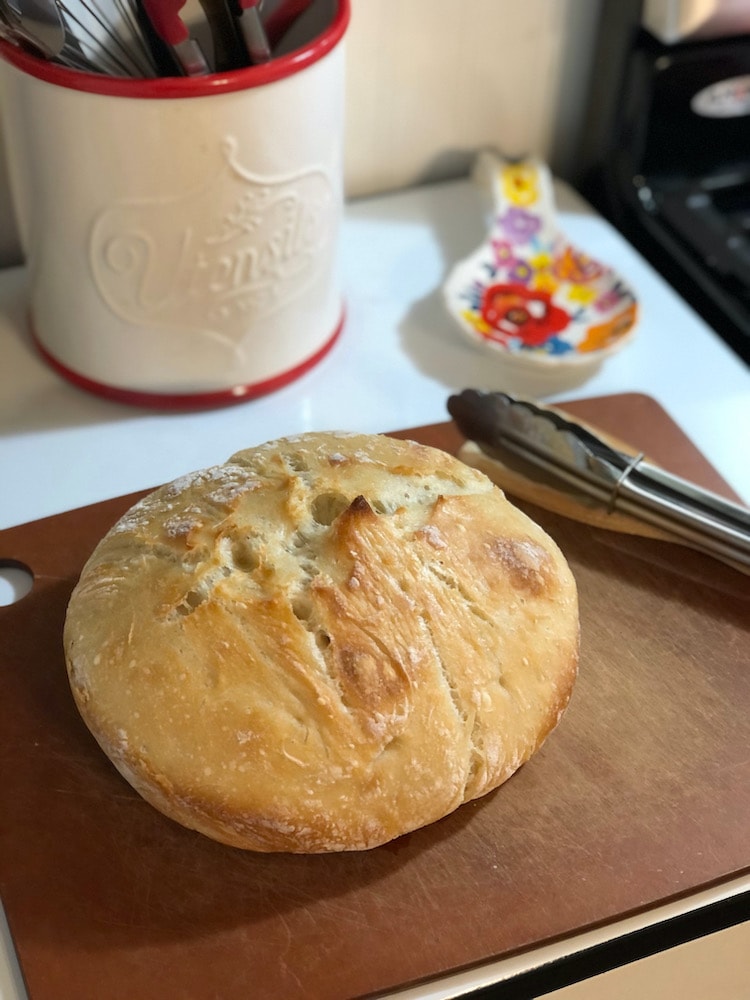
Bake bread for more old-fashioned homemaking
Making bread is one of my favorite things. I love smelling it as it’s baking, wafting through my house. That first bite is just incredible and so worth the wait. It’s one of those things that just feels old-fashioned. And honestly, like cooking with cast iron, it’s relatively easy to do once you get the hang of it. I do both artisan breads in the oven and I have a bread maker that I make our sandwich bread in, every couple of days. Even though a bread maker isn’t really “old-fashioned”, it is so simple to make your regular sandwich bread in. I highly recommend it for that purpose.
But the art of making artisan bread in your oven; it slows down the pace of life.
Eat your leftovers to limit waste
Make an effort to eat your leftovers. You can eat it as the same meal two days in a row, even plan out your meal plan that way. Or you improvise and add a few new ingredients the next day, to create a slightly different meal. This can save you a ton of money. And I bet grandma didn’t let precious food go to waste.
Eat dinner together as a family, with no cell phones allowed at the table
Let’s bring this one back, please. Some real, quality family time with no interruptions from cell phones. Think about looking each other in the eye and having conversations as a family. Savor each bite of your food, instead of just gobbling it down. Laugh together. If you’re religious, hold hands and say grace before the meal. Thank the Lord for His blessings of good food to eat, a roof over your head and family to feed. This is what we work for.
Use real dishes instead of disposable
There is just something about using real dishes at the table. Sure, using disposable dishes during certain periods of life is helpful. Instances like if you’re sick, just had a baby, are renovating the kitchen, or on vacation, I can totally understand using these. But try using real dishes in regular life if you want more old-fashioned homemaking.
Write down your family’s favorite recipes in a notebook or binder
Start a recipe binder or card set with the recipes that are meaningful to your family. If you don’t write it down or teach your children how to make it, they won’t have it for future generations. And when you write it down, be very specific. If you use specific products in the recipe, write down the brand you use if it matters to the taste. It took 5 years for our family to crack the code for what brand of mayo my mother-in-law used in her macaroni salad. It didn’t taste the same as her’s until we used the right brand.
We remember the tastes that meant a lot to us as children. There is a reason why, “it’s not how my mama used to make it” is a popular saying.
Use towels and cloth napkins instead of paper towels and disposable napkins for more old-fashioned homemaking
Not only does having cloth napkins at your kitchen table look beautiful, but it saves money and is reusable. Same goes for kitchen towels for drying dishes and drying your hands.
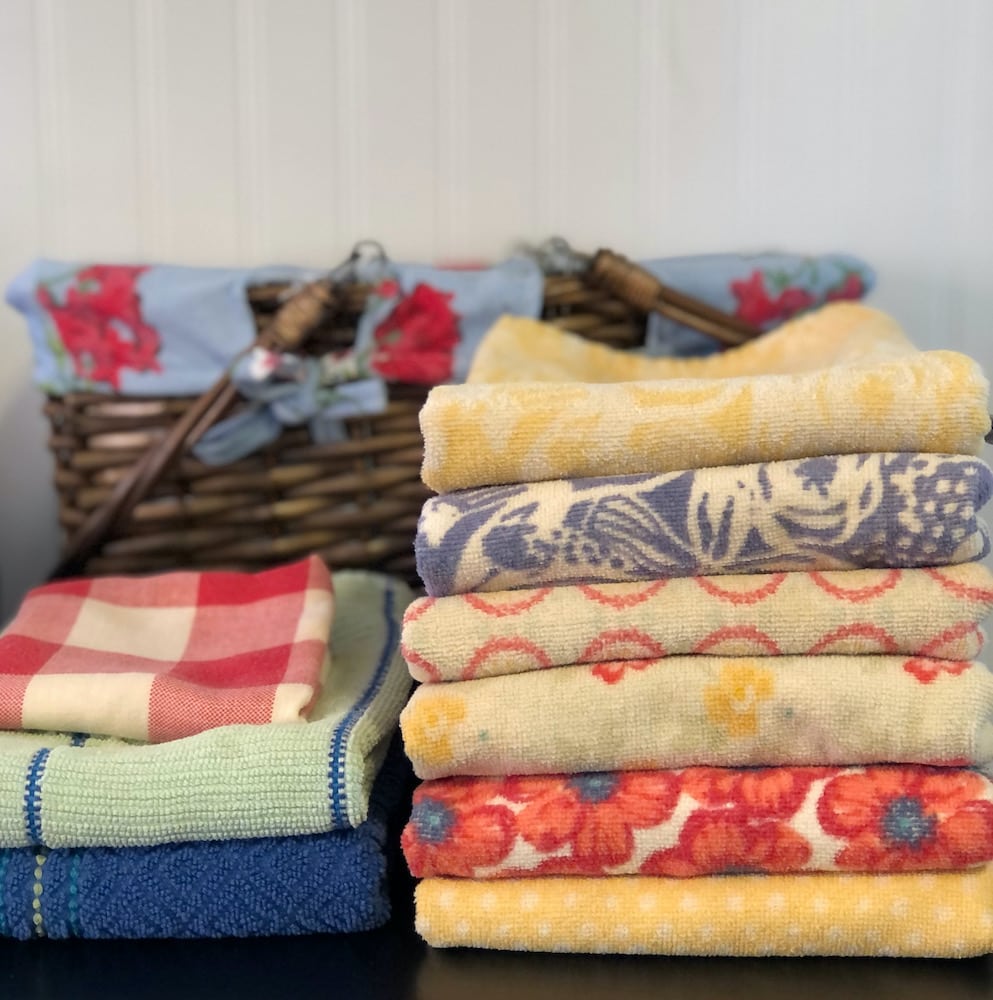
Keep a decent pantry of staple foods
Keep staple foods on hand at all times. This will make it easier for you craft meals from your pantry and keep you a bit more supplied in case of emergency. These items are pretty long lasting if preserved correctly.
One thing I do is almost every pantry item except for canned goods, goes straight into my freezer for about a week right when I bring it home from the grocery store. What this does, and it sounds gross, but it kills any bugs or eggs that could be living in the product. This way you don’t bring a product into your panty that could spread these bugs to other items. Then I put all my pantry items into air-tight jars or containers. Another thing to keep in mind, is “first in, first out”. Make sure your supply is rotated so nothing in your pantry goes past it’s prime.
Here is just a short list of items I suggest:
Flour, sugar, cornmeal, dried beans, lentils, rice, pastas, nuts, oat meal & canned goods.
Wash & re-use what you can (baggies, aluminum foil, finished yogurt tubs, etc.)
Some people nowadays might look at you funny for this one, but I bet grandma would be proud. Wash out and re-use some of the everyday “disposable” items you use.
Items like baggies are kind of hard to dry out properly. I’ve even seen racks you can buy to hold items like this open to dry easier. But honestly, I’ve just used chopped sticks or butter knives before to hold open baggies to dry in my dish strainer and that’s worked just fine.
Big yogurt tubs are great and easy to re-use as well. Especially with the holiday season coming up, you can start saving these now. When guests come over for Thanksgiving or Christmas, you can then send them home with some leftovers of the meal, in a container you don’t have to worry about getting back.
Learn how to can
Learn from a reputable source how to properly can food. This is an old-fashioned way of preserving the harvest for winter-time. This can either be from your own gardens or buying in bulk from local farmers or farmers markets.
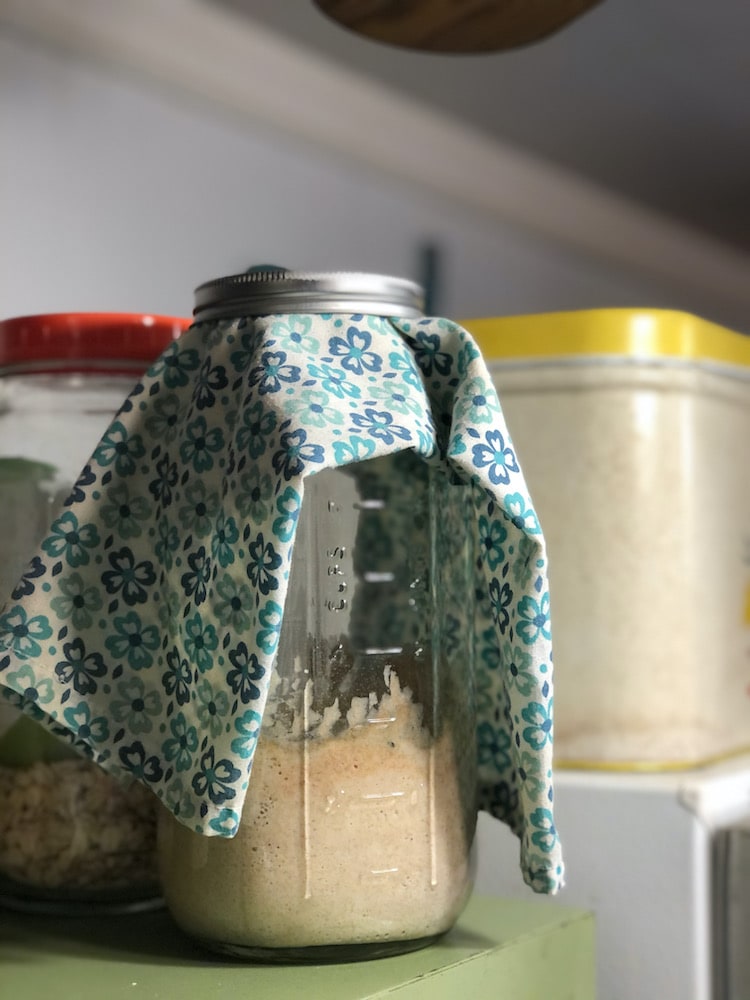
Learn to make sourdough for more old-fashioned homemaking
Sourdough is another one of those things that seems intimidating but is really simple once you get the hang of it.
I started my first sourdough starter last year using this recipe How to Make Your Own Sourdough Starter by The Praire Homestead. It came out so well, and I made all sorts of yummy sourdough recipes with it. When I kept it out, I was so good at keeping it. I “fed” it frequently and it was super healthy. Then I put it in the fridge and unfortunately, this starter died of neglect. But I learned how to do it, and can definitely make one again in the future.
It was such a great experience and I highly recommend it.
Laundry Time
Learn how to sew a button & mend clothes
This is definitely a lost art. When was the last time you heard someone say they darn their socks? Or that they used that little replacement button that came on the tag of the shirt?
I’m not perfect with this one either, although I have done each of those things. Our grandparents generation did this out of necessity. Clothing is much cheaper nowadays, which is why this is no longer common to do. But I say we bring this one back. It still saves money and by doing this, you tend to buy higher quality clothing items that last.
Another great reason to mend your clothes is that it takes you out of “fast fashion” and the consumerist mindset. You buy clothing items that are classic instead of trendy, developing your own style in the process.
Hang your laundry on the line to dry for more old-fashioned homemaking
I love driving by homes that have laundry hanging on the line. Out in the country this is very common to see.
But you don’t have to have your clothes drying outside to do this. There are plenty of smaller, in-door clothes drying racks, too. If you have a smaller space, like an apartment in a city environment, I have a trick.
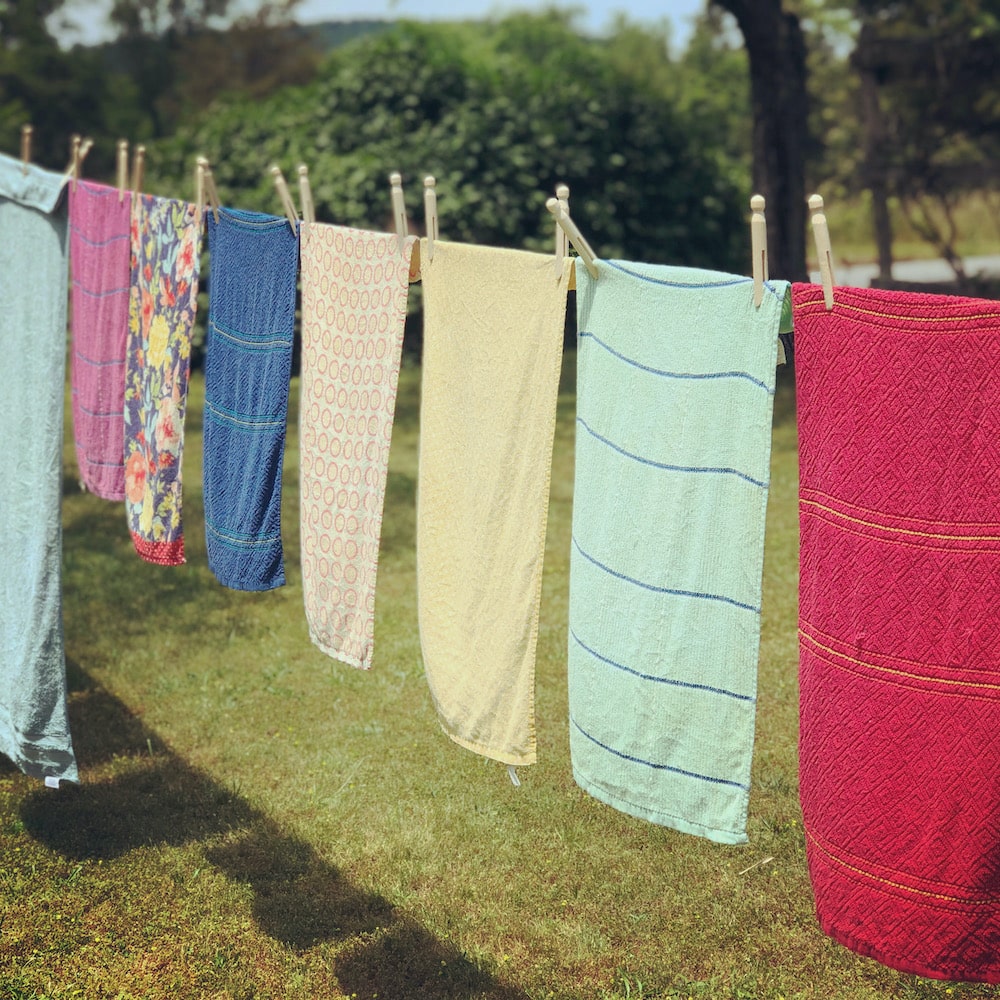
I used to put my in-door rack into my bath tub. Sometimes I would even draw the shower curtain, especially if guests were coming over. This way, the rack wasn’t in my way while it was drying. Plus, any water coming off the clothes went into the tub instead of onto the floor. It takes a little bit longer to dry if you close the curtain, because of less air circulation. This is definitely worth doing, especially for clothes that are delicates.
Wardrobe
Donate your gently used but unwanted items to the thrift store instead of trashing them. Also buy items you need from the thrift store!
Instead of just throwing away items that are perfectly useable still, donate them to the thrift store. This helps a good cause and keeps the item in use longer. Also, buy the things your need form the thrift store, especially clothing. It’s cheaper and a lot of times you can still get high quality, name brand items, that have been barely used.
For Babies & Children
Use cloth diapers for your babies
Cloth diapers nowadays are SO much better than what generations past had to use. Long gone are diapers pins. They have snaps or Velcro. All-in-ones (the cloth and water-resistant cover are connected) or two-parts (the cloth and the cover seperate either with a pocket or no pocket). Cotton, hemp, microfiber, fleece. Organic or non-organic. Solid colors or prints. So many choices.
If you are just starting out, I would recommend doing snaps, because they are harder for little ones to remove themselves compared to velcro. After trying both all-in-ones and separates, I would go with the seperates. This method is less expensive. You hang dry the cover, which makes it naturally last longer. You can either hang dry the pads or put the pads through the dryer so they dry quickly and easily as well. I would recommend using organic cotton as top cloth layer, this helps guard against diaper rash and is healthy for baby’s skin. Organic hemp is super absorbent and is great to use as the subsquent absorbent layer(s). As for fun colors and prints, that’s up to you!
Not only was this what I planned on doing before my baby arrived, but it helped so much at the beginning of the pandemic, when diapers were hard to find. I didn’t have to worry about it, because I had re-usable cloth diapers.
Use hand-me-downs for children’s clothing when possible and buy from the thrift store
Save your children’s clothing for your next child, to get a head-start on their wardrobe. When they need new pieces, shop at the thrift store first.
Homestead
Start an herb garden or vegetable garden
What list would be complete without starting a garden? This is an example that could be as small as an herb garden on a windowsill. Or a couple raised beds or a container garden on your porch. Or you can go as large as growing all the fruit and veggies your family needs for the year. I’d say start small though. Learn about gardening, and try one or two things to plant at a time.
Our grandparents generation definitely did this. Old-fashioned self reliance. Some did it because they had farms, others did what was termed “Victory Gardens” during WWI & WWII. Click that link to read a great article explaining how victory gardens worked and why, but also how to start your own today.
Keep farm animals like backyard chickens
If you live in an area that allows for having backyard chickens, this is definitely something to look into.
House cleaning
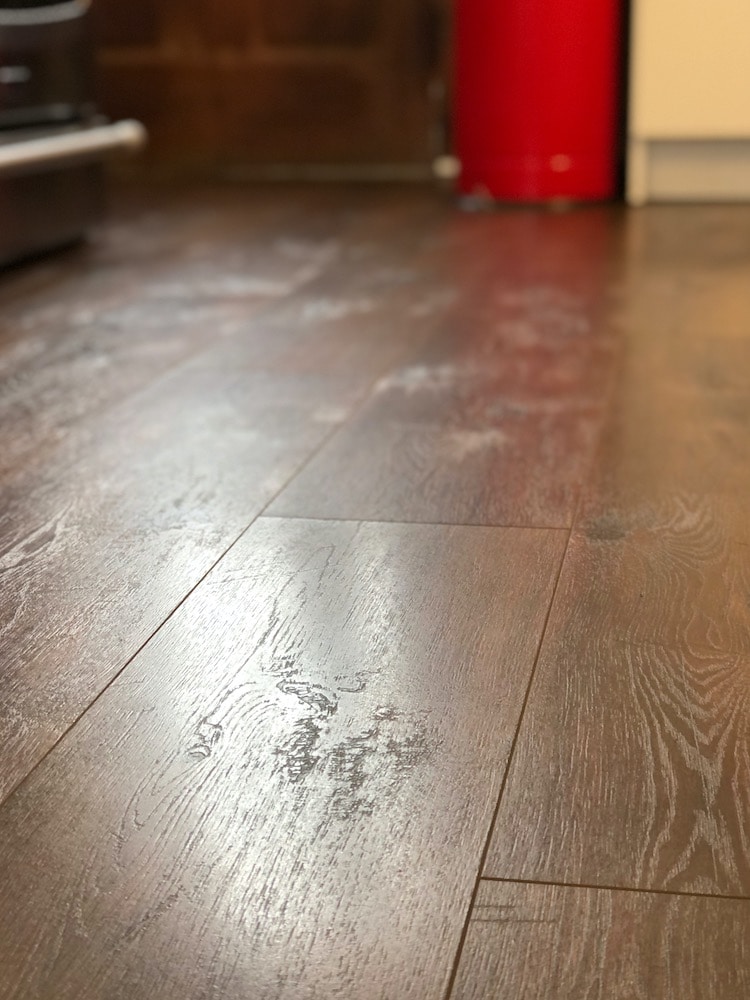
Use a broom and dust pan for more old-fashioned homemaking
Instead of bringing out your vacuum, clean up your floors with a broom and dust pan. If you grew up with only using a vacuum, this will definitely feel old-fashioned to do. You’ll use less electricity, too.
You can invest in a really good quality broom and dustpan. I really want to get one of the Amish made ones that they sell locally to where I live. But you can also order them online, through a company like Lehmans (not an affiliate, just a recommendation).
Wash your dishes by hand instead of in the dishwasher
I honestly just bought my first dishwasher this past year. I never had one before. So, of course, I still wash a lot of my dishes by hand because I’m just used to it. But to be honest, there are some benefits of using a dishwasher instead. Today’s dishwashers use less water than washing by hand and you are getting more time back into your day. But if you want to rely less on technology and do more old-fashioned homemaking, that could mean choosing to wash your dishes by hand. At least doing so more often and lessening the amount you use a dishwasher. Maybe you can run the dishwasher every other day instead of every day. Or use the dishwasher when you have had guests over and have a lot more dishes than usual, but generally just wash by hand in daily life.
Follow an old-fashioned homemaking routine
A lot of the old-fashioned homemaking books I have read talk about establishing a homemaking routine. This sometimes means doing a certain homemaking task each day of the week. Like, Mondays are laundry day. Saturday is baking day. And so on. In one of my favorite old-fashioned homemaking books, it reads,
“Housekeeping is a real job – a job that needs to be planned carefully if one would avoid becoming a slave to housework or have free time for social activities and outside interests. The easiest way to plan housework is to make a schedule which assigns each household task to the particular day – or perhaps even the particular hour – when it can be done most quickly and conveniently.”
Home Institute, N. Y. H. T. (1941). Chapter II: Budgeting Your Time. In America’s housekeeping book (1947 Edition, pp. 9–9). essay, C. Scribner’s Sons.
Although I have a copy of this book on my bookshelf, you can also read this book, America’s Housekeeping Book, for free online through OpenLibrary.org by clicking on the link I created on the book title. Of course, keep in mind some of the information is no longer useful or even something to avoid. Some of the chemical used in the 1940s are no longer in use today because they are not considered safe anymore. But the basic information in old-fashioned homemaking books are timeless. Plus, it’s interesting and fun to read how others lived.
Make your own cleaning solutions
Instead of buying store bought cleaning solutions, find some old-fashioned recipes to replace those products. Not only are they cheaper, but they are generally better for your family’s health and environment.
Re-use old clothing you can’t donate by turning it into cleaning cloths/rags
Instead of using paper towels or nice new looking towels, use rags to clean with. The beauty of this is that you can wash them and use them again for simpler routine cleaning jobs. If it’s a tough cleaning job you can just throw them away, because you’ve already given the item a second life by re-using it.
Wrapping Up
So to wrap up this post, I hope it inspires you to implement more old-fashioned homemaking in your life.
Be sure to check out the other posts I’ve written in this series below.
And keep an eye out for the next installment of the series, where I tackle another area of life.
Check out the rest of my A More Old-Fashioned Life Series
How to Live a More Old-Fashioned Life
Holiday Edition: A More Old-Fashioned Thanksgiving
Holiday Edition: A More Old-Fashioned Christmas
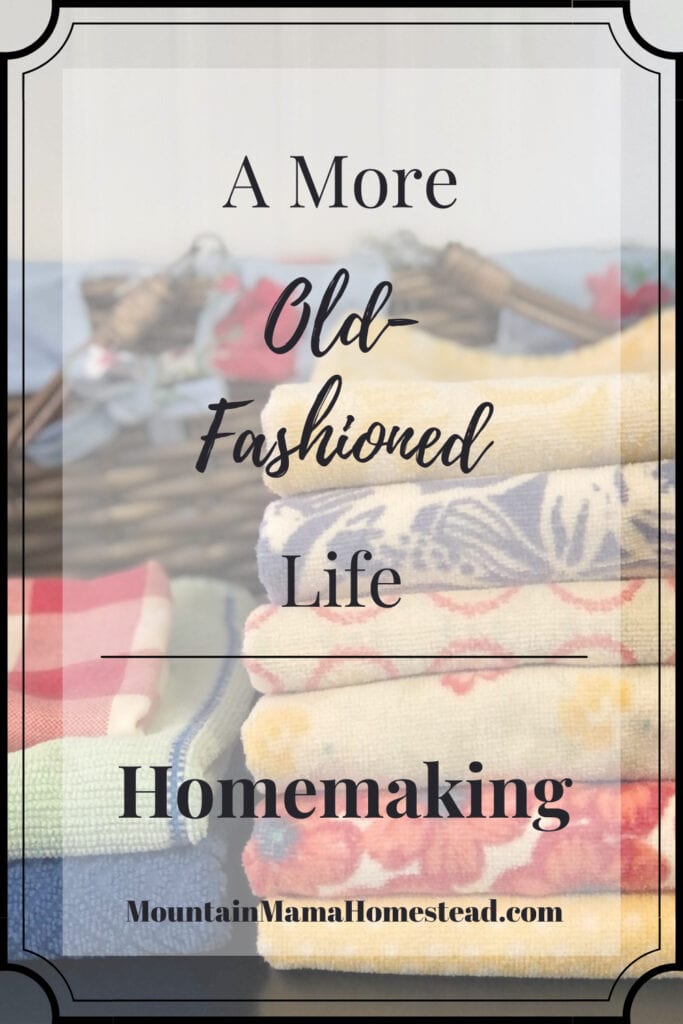
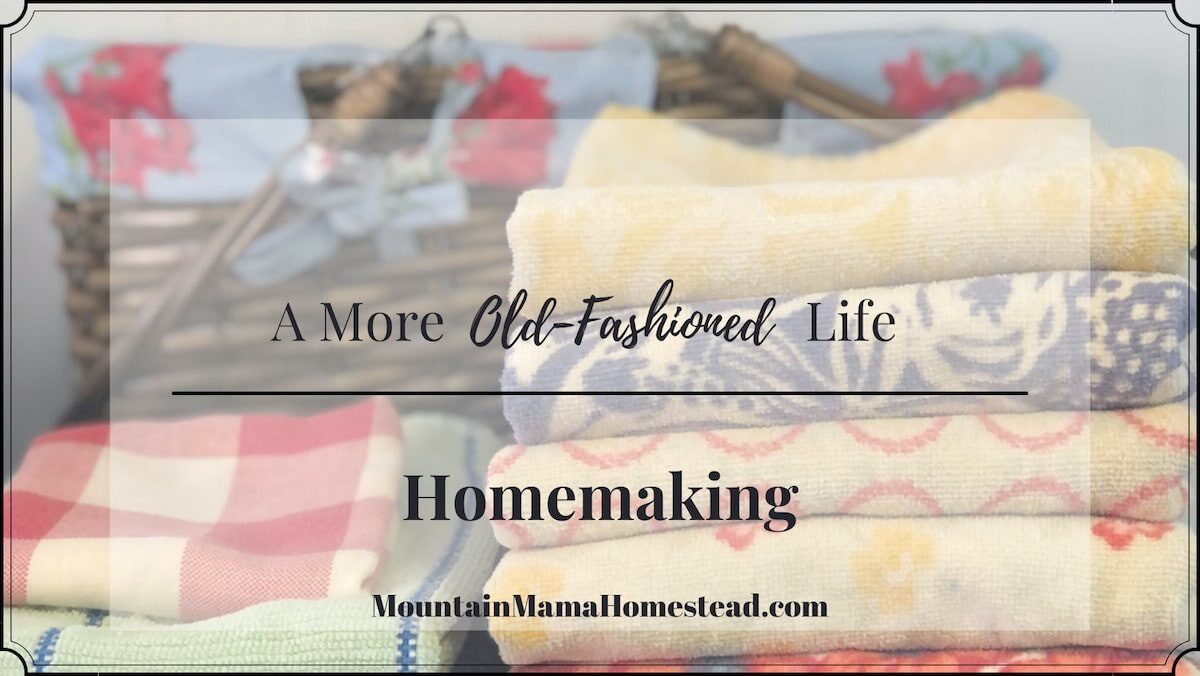
NANCY BROWN
Lots of helpful, great advice, Steph. Patrick just cooked me some filet mignon last night, first in a cast iron skillet, then in the oven in the pan for a short time. Absolutely delicious and easy to chew. I loved it. I always loved Cast iron. And the bone broth idea, Patrick does that too. Your blog is a great way to tell people how to save money, eat more healthy, and bring the family closer together.love this.
Mountain Mama
Thank you so much!! Yes, I agree, I love how versatile cast iron is as well! That’s my goal 🙂
Savannah
I absolutely love this post! I was reading and all I could keep saying was, “Yes, 100% I agree!” Haha! These ideas feel so normal to me but this post is great for those who are “new” to the idea.
Mountain Mama
Thank you so much! That is so great!! That makes me so happy to hear!
Sadie
I love these ideas! I think it’s great that we are not the only family reusing and washing foil, plastic baggies, and other containers! Lots of great advice here. Thank you for sharing!
Sherry
Hmmmm…..I must be old fashioned at heart…I do almost all of these things and have for years. There is nothing like fresh sheets just off the clothesline 😊 thank you for your post
Mountain Mama
That is such a good thing and I am so happy to hear that! And yes, I completely agree, fresh sheets off the clothes are so nice! Thank you so much for your comment 🙂
laurathebadwife
These are some great ideas! Thanks!
Mountain Mama
Thank you so much, Laura! 🙂
eatinghealthyspendingless
I absolutely loved this article! Living a simpler life is so much more fruitful, than living a busy on the go life. I have thoroughly enjoy using my sourdough starter, and ironing cloth napkins from dinner the night before. Thank you for this encouraging article.
Mountain Mama
I’m so glad that you enjoyed the article! Thank you so much 🙂